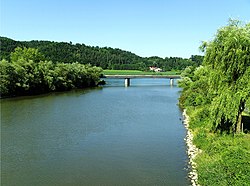
The Main is the longest tributary of the Rhine. It rises as the White Main in the Fichtel Mountains of northeastern Bavaria and flows west through central Germany for 525 kilometres (326 mi) to meet the Rhine below Rüsselsheim, Hesse. The cities of Mainz and Wiesbaden are close to the confluence.

The Iller is a river of Bavaria and Baden-Württemberg in Germany. It is a right tributary of the Danube, 146 kilometres (91 mi) long.

The Inn is a river in Switzerland, Austria and Germany. The 518 km (322 mi) long river is a right tributary of the Danube, being the third largest tributary of the Danube by discharge. The highest point of its drainage basin is the summit of Piz Bernina at 4,049 m (13,284 ft). The Engadine, the valley of the En, is the only Swiss valley whose waters end up in the Black Sea.

Ingolstadt is an independent city on the Danube in Upper Bavaria with 139,553 inhabitants. Around half a million people live in the metropolitan area. Ingolstadt is the second largest city in Upper Bavaria after Munich and the fifth largest city in Bavaria after Munich, Nuremberg, Augsburg and Regensburg. The city passed the mark of 100,000 inhabitants in 1989 and has since been one of the major cities in Germany. After Regensburg, Ingolstadt is the second largest German city on the Danube.

The Ilz is a river running through the Bavarian Forest, Germany. It is a left tributary of the Danube. During its 40 km (25 mi) length, it travels down a height difference of ~140m.

The Amper, called the Ammer upstream of the Ammersee, through which it runs, is the largest tributary of the Isar in southern Bavaria, Germany. It flows generally north-eastward, reaching the Isar in Moosburg, about 185 kilometres (115 mi) from its source in the Ammergau Alps, with a flow of 45 m³/s. Including its tributary, Linder, it is 209.5 km (130.2 mi) long. Major tributaries are the Glonn, which rises near Augsburg; the Würm, which is the outflow of Lake Starnberg; and the Maisach.

The Paar is a river of Bavaria, Germany. It is a right tributary of the Danube. For several tens of kilometers, the Paar flows parallel to the Lech, at only a few km distance. Near Augsburg, the Paar leaves the Lech valley and turns north-east towards Ingolstadt. It flows into the Danube near Vohburg. Towns and municipalities along the Paar include Egling, Mering, Aichach, Schrobenhausen and Manching.

The Würm is a river in Bavaria, Germany, right tributary of the Amper. The length of the river is 39.8 kilometres (24.7 mi), or 76.3 kilometres (47.4 mi) including the Steinbach, the main feed of Lake Starnberg. It drains the overflow from Lake Starnberg and flows swiftly through the villages of Gauting, Krailling, Planegg, Gräfelfing and Lochham as well as part of Munich before joining, near Dachau, the Amper, which soon afterwards flows into the Isar and eventually into the Danube. Although the Würm is not a very large river, it is well known as it gave its name to the Würm glaciation.

The Schmutter is a river in Bavaria, Germany, a right tributary of the Danube.

The Wertach is a river in Bavaria, southern Germany. This 141 km (88 mi) long river is a left tributary of the Lech. The Wertach originates in the Northern Limestone Alps in Bad Hindelang, east of Sonthofen. It flows north along the towns Wertach, Nesselwang, Marktoberdorf, Kaufbeuren, Schwabmünchen and Bobingen. The Wertach flows into the Lech in Augsburg, and has a deep reservoir with a hydroelectric power plant.

The Günz is a river in Bavaria, Germany.
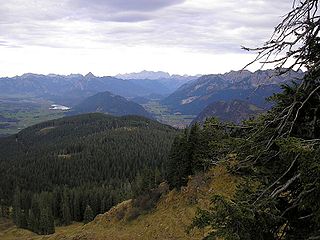
The Vils is a 36-kilometre-long (22 mi) river, a left tributary of the Lech in the Alps of Austria and Germany. The Vils has a drainage basin of approximately 200 km2 (77 sq mi), with an average annual precipitation of nearly 2,000 mm (80 in).

Große Laber is a river in Bavaria, Germany, a right tributary of the Danube.
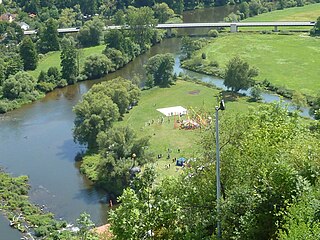
The Vils is a river in Bavaria, Germany.
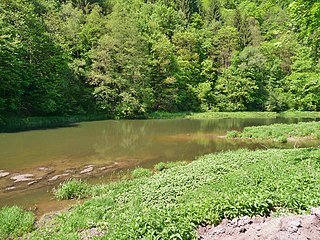
The Gaißa is a river in Bavaria, southeastern Germany, which is a tributary of the Danube. It flows through the Bavarian Forest from North to South, crossing Aicha vorm Wald and joining the Danube northwest of Passau. The river reaches a length of 19.9 kilometres (12.4 mi); including its source river Große Ohe which is 45.8 kilometres (28.5 mi) long. Due to the nearby motorway, a good deal of dirt was flushed into the water from time to time.

The Danube is the second-longest river in Europe, after the Volga in Russia. It flows through Central and Southeastern Europe, from the Black Forest south into the Black Sea. A large and historically important river, it was once a frontier of the Roman Empire. In the 21st century, it connects ten European countries, running through their territories or marking a border. Originating in Germany, the Danube flows southeast for 2,850 km (1,770 mi), passing through or bordering Austria, Slovakia, Hungary, Croatia, Serbia, Romania, Bulgaria, Moldova, and Ukraine. Among the many cities on the river are four national capitals: Vienna, Bratislava, Budapest, and Belgrade. Its drainage basin amounts to 817,000 km² and extends into nine more countries.

The Memminger Ach is a river of Bavaria, Germany.
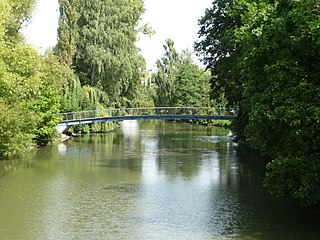
Große Vils is a river of Bavaria, Germany. At its confluence with the Kleine Vils near Gerzen, the Vils is formed.

The Kleine Laber is a river in Bavaria, Germany. The Kleine Laber issues into the Große Laber, which issues into the Danube River.
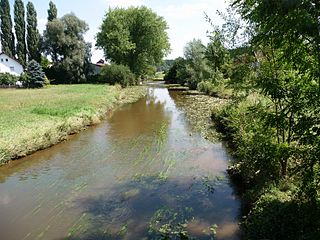
Kleine Vils is a river of Bavaria, Germany. At its confluence with the Große Vils near Gerzen, the Vils is formed.
